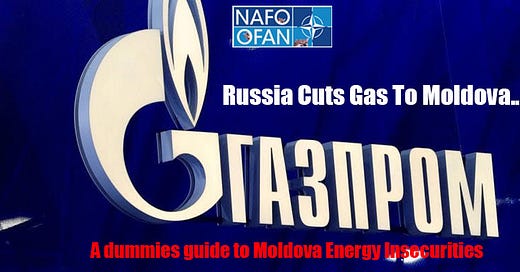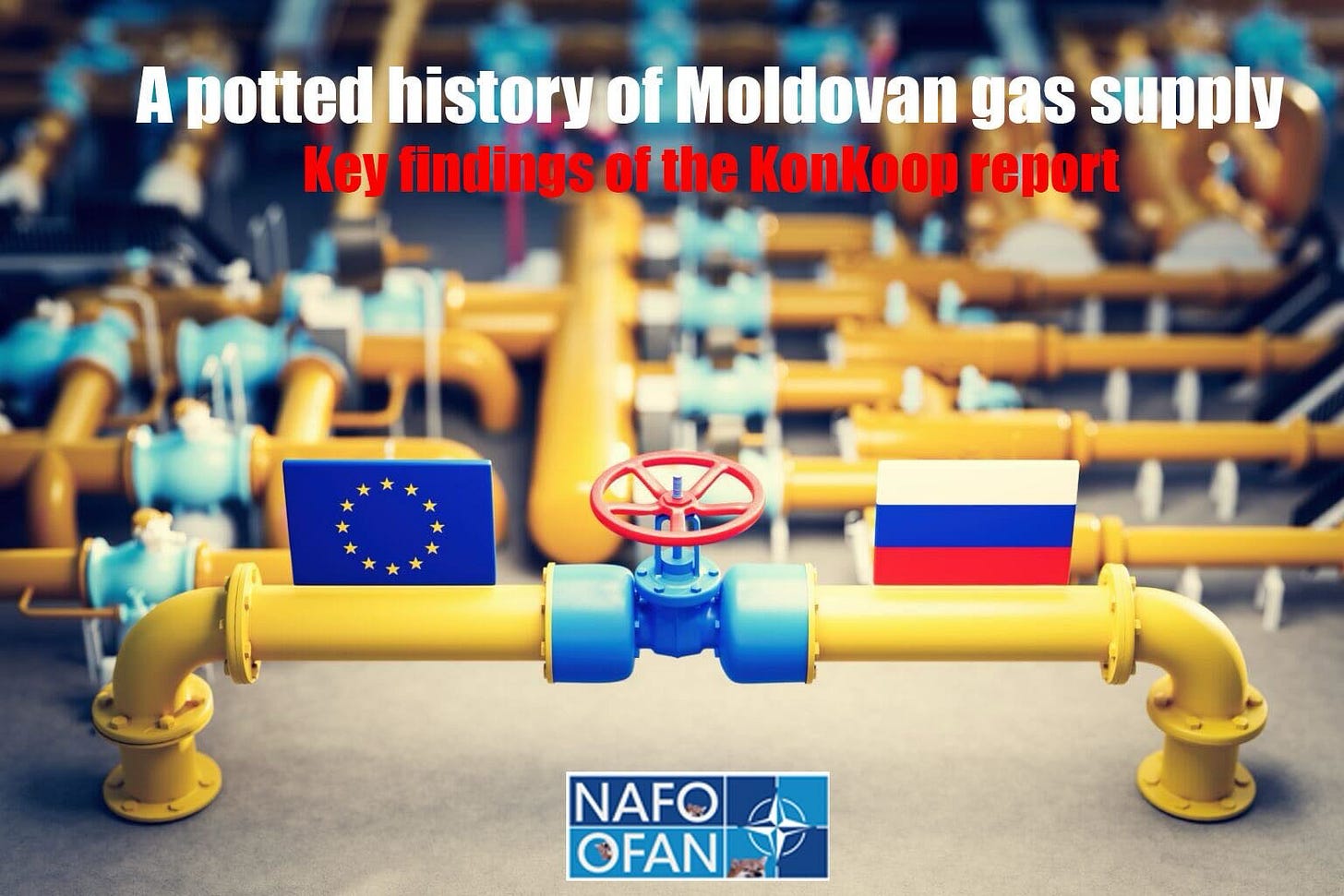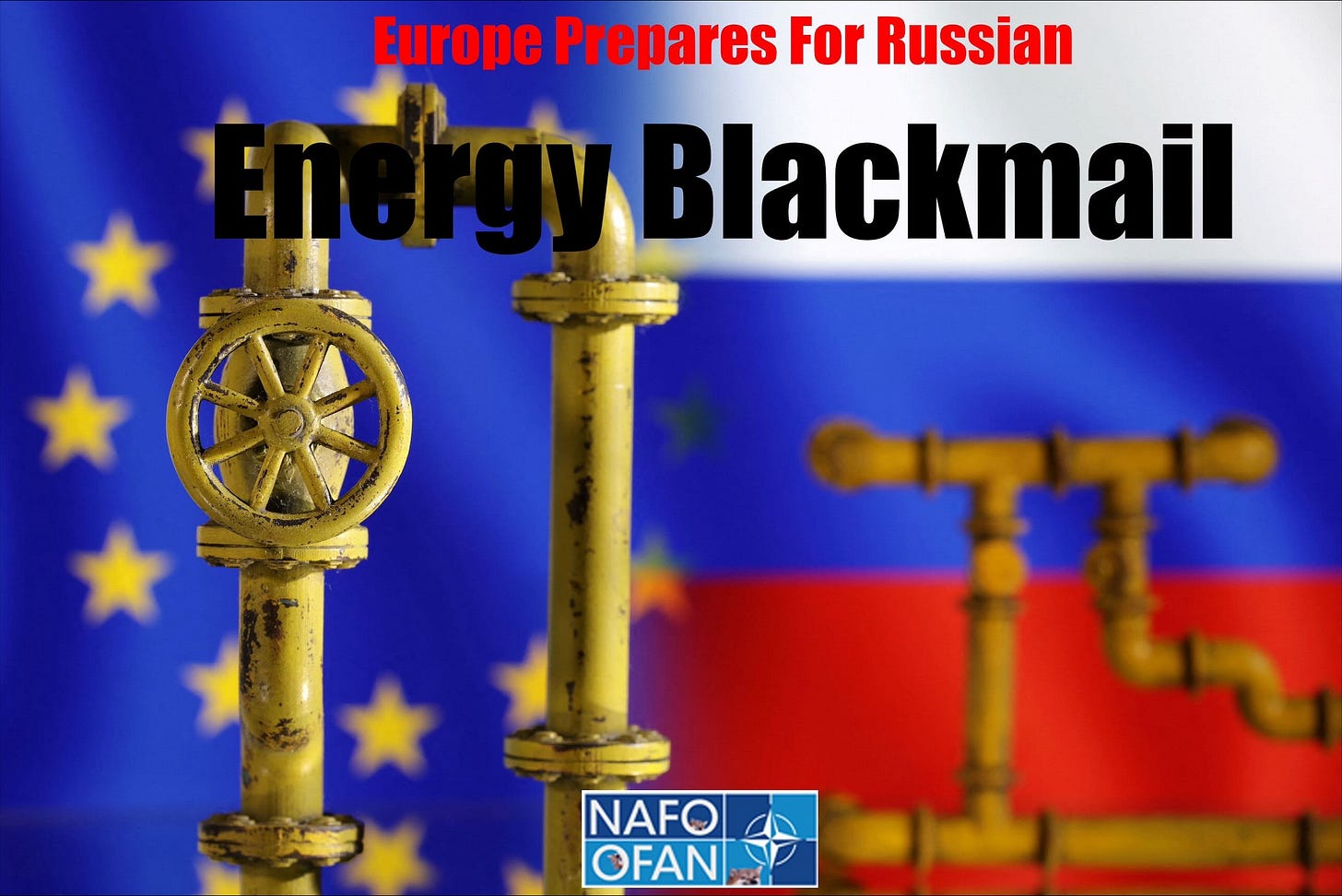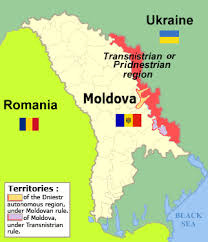Russia cuts gas supplies to Moldova from January 01, 2025
A dummies guide to Moldovan Energy supply and insecurities.
The announcement that Russian gas transit via Ukraine will cease in January 2025 - is changing the energy dynamic in Europe and redefining supply and diversification strategies.
Russia’s war against Ukraine exposed the vulnerabilities that come with energy dependence on Russia. For states across Europe, the need to decouple from the Russian energy system was clear. This decoupling process has been especially challenging for Eastern European countries so embedded in Russia’s energy infrastructure.
This thread focuses mainly on the Moldovan energy infrastructure vulnerabilities, it does not detail the political situation in Moldova and the Ukraine disconnection of transiting russian energy supplies - which do need to be taken into considered too, but in a separate thread.
The thread summarises key findings from important publications, and full credit is given to the sources in the references for your further reading and verification. If you are interested in diving into a fascinating history of Moldova, Transnistria and Russia - be sure to read my article here:
https://beefeaterresearch.substack.com/p/moldovan-and-transnistria?r=4r2ohh
______________________________________________________________________
In December 2024, Moldova’s parliament voted in favour of imposing a state of emergency in the energy sector over fears that Russia could leave Moldova without sufficient energy this winter.
AP reports on December 28, 2024 “Russia’s state-owned energy giant Gazprom said Saturday it will halt gas supplies to Moldova starting on Jan. 1, citing alleged unpaid debt by the European Union candidate country, which has brought in emergency measures as it braces for power cuts.
Gazprom said in an online statement that it reserved the right to take further action, including terminating its contract with Moldovagaz, Moldova’s main gas operator, in which the Russian company owns a majority stake. The cessation of gas will stop supplies to the Kuciurgan power plant, the country’s largest, which is situated in the separatist pro-Russian Transnistria region.
Moldova reacted by accusing Moscow of weaponising energy supplies.
Gazprom supplies the gas-operated Kuciurgan plant, which generates electricity that powers a significant portion of Moldova proper. The plant was privatised in 2004 by Transnistrian officials and later sold to a Russian state-owned company. Moldova, which has a West-leaning central government and has repeatedly complained of Russian interference, doesn’t recognise the privatisation.”
A special commission was also set up to manage “imminent risks” if Moscow fails to supply gas to the Kuciurgan plant and on Friday approved a series of measures aimed at saving energy.
Gazprom has said Moldova owes close to $709 million for past gas supplies, a figure fiercely disputed by the government in the capital Chisinau.
Moldovan Prime Minister Dorin Recean on Saturday condemned the move, saying that his government does not recognize the debt cited by Gazprom, which has been “invalidated by an international audit.”
Moldova claims, citing findings by British and Norwegian audit firms, that its debt stands close to $8.6 million, a small fraction of that claimed by Gazprom.
Recean added that Chisinau has pushed to diversify its natural gas supplies to reduce dependence on the Kuciurgan plant, and said the government will “carefully analyze legal options, including resorting to international arbitration” to protect Moldova’s national interests.
“Our country is prepared to handle any situation that arises following the Kremlin’s decision,” he said.
Moldova’s government on Friday announced it would implement a series of measures starting Jan. 1 to reduce energy consumption. These include limiting lighting in public and commercial buildings by at least 30%, and energy-intensive businesses operating during off-peak hours.
👉 The KonKoop Security Report looks at how three Eastern European countries have gone about severing their energy ties to Russia. Moving eastwards from the protection of the European energy umbrella in Latvia to peripheral Moldova and wartime Ukraine, we can see how energy security becomes more precarious. In all three countries energy geopolitics is intertwined with the perceptions and fears of ordinary consumers.
The report found that Russia used to supply gas to Moldova at preferential prices in exchange for political concessions. This changed after February 2022, when the pro-Western government in Chisinau moved quickly to reduce Moldova’s dependency on Russian energy. Together with Ukraine, Moldova disconnected from the Brell grid just hours before the full-scale invasion.
“It has since been able to secure gas deliveries from Romania at subsidised prices and connected to the European continental network. Attempts by Russia to play the energy card to destabilise the government in Chisinau and heighten tensions with the breakaway pro-Russian region of Transdniestria have therefore been in vain. With alternative routes and supplies of energy, Moldova ‘can escape the Kremlin’s grip’.
Russia’s war against Ukraine has revealed how pivotal the energy sector and the industries connected to it are to Europe. It demonstrated how vulnerable states are with regard to their energy supply, infrastructures, and ultimately perceptions of energy security. The war forced in particular EU member states and the EU at large to rethink their respective energy strategies and security in terms of energy sovereignty in general and reliance on Russia in particular.
New dividing lines in European energy and environmental policies overturned long-held beliefs about energy-generated peace. The hurried but successful connection of Ukraine’s and Moldova’s power networks to the EU grid following the invasion ensured their partial inclusion in a European ‘energy safety net’ and laid bare the material dimensions of energy security”.
Next 👉 Moldova’s dependency
Traditionally, Moldova has been fully dependent on network-bound gas and electricity supplies from Russia. This dependence came at a high price in both a material and a figurative sense. This contribution sheds light on the difficult path Moldova has chosen on its way to emancipating itself from Russian energy dominance in order to strengthen its resilience and energy security.
Russia used to supply all the gas consumed by Moldova – about 3 billion cubic meters (bcm) in total – of which 1 bcm was used for heating and electricity on the Chisinau-controlled ‘right bank’ of the Dniester and 2 bcm went to separatist Transdniestria. The latter used it both in energy-intensive industry and to produce electricity through the Kuciurgan power plant owned by the Russian Inter RAO, which covered up to 80 per cent of the right bank’s needs. Alternatively, Chisinau could import electricity from Ukraine.
Moldova’s highest energy security vulnerabilities were thus related to Russia’s capacity to cut supplies of gas directly at any moment, while potentially triggering an electricity crisis if Ukrainian energy was also not available. This dependency was inescapable as long as Moldova did not have physical access to alternative sources of energy from the European market.
👉 The carrots and sticks of affordability and accessibility
Since autumn 2021, Russia has intensified its hybrid warfare against Moldova. It attempted to destabilise the political situation by cutting supplies to ‘unfriendly’ Chisinau, demanding repayments of historical (partly fabricated) debts on gas, and fuelling social unrest and separatism, in both Transdniestria and the autonomous region of Gagauzia.
The Kremlin’s main objective is still to prevent Moldova from escaping Russian influence and to derail efforts by the current Moldovan leadership towards European integration. Key examples of Russia’s use of energy to this end in the past two years will be explained below.
Moldova has physical access to gas and electricity from Europe. Nevertheless, procuring supplies on the European market implies competition and market-based prices. By contrast, Russia could always supply gas – in some cases for free, even if that meant extorting political concessions in lieu of payment. ‘Free’ gas ensured Transdniestria’s survival over the past decades.
In Gagauzia, the controversial governor Evghenia Guțul (recently sanctioned because of her ties to the Kremlin) played the ‘energy card’ to get elected and afterwards, to pressure Chisinau for a cabinet seat. She thus built a strong political campaign against the pro-Western Chisinau authorities, claiming that Gagauzian citizens would benefit from Russian gas prices 10 to 20 times lower than what Chisinau negotiates for the rest of the country.
Though the claim about cheaper energy compared to the rest of Moldova is demonstrably false, it remains one of the key disinformation narratives used by the Kremlin to fuel social unrest and steer the country away from the European path.
In the heating season 2022/2023, Russia reduced its gas supply to Moldova, first by 30 per cent in October, then by 50 per cent in December, possibly hoping that mass protests would bring down the pro-Western government.
In addition, Gazprom’s reduction of gas deliveries created tensions between Chisinau and Tiraspol over the distribution of the remaining Russian supplies. Chisinau demanded a proportional reduction of deliveries to the left and the right bank of the Dniester. Tiraspol meanwhile insisted on receiving the entire quantity delivered by Gazprom, threatening that it would otherwise cut electricity supplies to the right bank from the gas-fired Kuciurgan power plant. These supplies made up 70 per cent of all Moldova’s electricity at a time when Ukraine, the alternative supplier, had stopped all exports following Russia’s attacks on the country’s power grids in October 2022.
Kuciurgan did indeed stop supplying electricity to the right bank. The Kremlin had obviously calculated that Chisinau would cut gas to Transdniestria in response, potentially triggering a humanitarian crisis ahead of the winter. However, Chisinau did not fall into that trap and continued to deliver supplies to the breakaway territory. In September 2022, during negotiations on gas supplies, Gazprom demanded that Moldova’s gas company Moldovagaz acknowledge a historical debt of over 700 million USD and pay it immediately under threat of non-renewal of contract. Blackmailing with historical debts had been used successfully in previous decades to extort political concessions or gain increasing control of critical infrastructure from Moldova.
👉 Next: Europe and Chisinau’s response: improved accessibility and negotiated affordability
Russia’s intention to use energy to blackmail the Moldovan government became more obvious in late 2021. The substantially enhanced resilience of Moldova’s energy sector today is due to the rapid response of the EU and Romania to this threat.
This response included:
1) the acceleration of infrastructure investments;
2) financial support for consumers to ensure affordability of EU supplies; and
3) strong institutional support to finally clear the issue of Moldova’s arrears to Gazprom.
Interconnection projects were completed in late 2021 for gas (operationalisation of the gas pipeline with Romania) and early 2022 for electricity (emergency synchronisation of Ukraine and Moldova’s grids with the European Network of Transmission System Operators for Electricity [ENTSO-E]).
As a result, Russia’s ability to blackmail Moldova with outright cuts was weakened. If anything, Russia’s threats accelerated the interconnections rather than discouraging Moldova to approach the EU. To date, given the configuration of the power grid, the residual supply security issue concerns the continued flow of electricity from Romania to Moldova through the Russian-controlled power plant in Kuciurgan. However, there are plans to build new power lines by 2027, which would allow Moldova to completely bypass this power plant.
Moldova also signed a Memorandum with Romania in December 2023 to accelerate interconnectivity by building two or possibly three new power lines and to develop market institutions needed for a complete commercial interconnectivity with the EU electricity and gas market. The first two power lines are due to be operational in 2025 and 2027, respectively
👉 The Hybrid CoE Report findings
A critical analysis of Moldova’s critical infrastructure which is being targeted by Russia, was also published by Lucjan Kubica of The European Centre of Excellence for Countering Hybrid Threats (Hybrid CoE) in January 2024.
The report (link in references), calls out Moldova’s energy sector, specifically in gas and electricity. An abridged summary makes for a useful introduction to the subject, please take the time to read the full report though!
“Until recently, Russia was Moldova’s sole gas supplier. However, thanks to its diversification policy and financial assistance from the EU and the US,12 Moldova has been able to break Russia’s monopoly. Currently, Chisinau can choose between different suppliers and, in the event of disruptions, easily replace Russian gas, much of which goes to the separatist Transnistria region in any case.
Despite these improvements, Moldova remains vulnerable to Russian energy blackmail. There is still some scope for the Kremlin to manipulate energy deliveries in order to put additional pressure on the Moldovan electricity system to create social discontent. That was the case during the 2022–2023 winter season, which was characterised by ever-increasing energy prices.
Russia played with the fact that alternative non-Russian gas deliveries remained expensive, overstretching Moldova’s budget, duly preventing the state from decreasing prices for the population. During the period of high prices, the Kremlin pushed loyal pro-Russian parties to seize the momentum to stage social protests against the government.
In the electricity sector, Moldova remains even more vulnerable. The state buys around 70–80% of its electricity from a gas-fired power plant (Moldavskaya GRES), which is situated in the separatist Transnistria region and is controlled de facto by Russian company Inter RAO. The power plant is based on a gas agreement between Moldova and Russia. Any disruption in deliveries from the power plant would immediately jeopardise the functioning of the whole Moldovan electricity system.
👉 Transnistria energy conundrum
The separatist region of Transnistria and the division of the country create further vulnerabilities in the critical energy infrastructure, as the Moldovan authorities do not have full control over their own electricity lines. Transnistria is home to important electricity nodes responsible for transporting energy, for example from Romania to Moldova, which remain de facto under Russian control. This is another strategic infrastructure weakness that could easily be weaponised against Moldova in the form of sabotage.
Transnistria had already experienced some serious security incidents back in April, May and June 2022, including the firing of hand grenade launchers at separatist authority buildings in Tiraspol, and the detonation of explosives at local airports and Russian radio towers.
Another vulnerability of the Moldovan infra structure is the ownership of some strategic assets by Russian companies. The most prominent example is again the energy sector. Moldova’s largest and most important energy company, Moldovangaz, is owned by Russian gas giant Gazprom. Only recently, the Ministry of Energy announced that the transportation system would be separated from Gazprom and managed by a Romanian company under a five-year tender.
Similarly, in the transport sector, in 2022 the state took back control of the main airport in the capital Chisinau from a company owned by Russian millionaire Andrey Goncharenko. Experts underline the general weaknesses of the Moldovan transport infrastructure. The underdeveloped transport infrastructure does not allow the country to fully connect with the EU and to make the most of EU funds and investments. This includes basic issues such as the insufficient number of bridges (border crossings) on the River Prut linking the country to Romania, or the lack of a direct highway connection to Romania.
These deficiencies in turn slow down the economic transformation of the country. One example of that is the railway system, which was an integral part of the former Soviet railway network. This means that it has a larger track gauge compared to the rest of Europe, further constraining interconnectivity with the EU.
At the same time, the poor infrastructure makes it easier for malign actors to paralyse the country in the event of military or quasi-military operations. Moreover, the lack of properly developed infrastructure makes the country dependent on its neighbours, which in Moldova’s case generally means Romania.”
Where financial compensation for consumers was concerned, Chisinau pursued a strategy of guaranteeing alternative supplies at socially acceptable prices. In the winter of 2022/2023, the EU helped Chisinau to purchase emergency gas reserves, while Romania provided electricity, at subsidised prices, delivered primarily from state-owned companies.
For the Romanian public, such preferential treatment of Moldovans, on a par with what Romanian consumers enjoyed, was politically justified by the fact that up to one million Moldovans also have Romanian citizenship. Indicating that Chisinau had an alternative supplier, Romania’s deliveries of electricity were a particularly timely intervention that helped to defuse the tensions between Chisinau and Tiraspol over how to split the Gazprom deliveries.
Starting in December 2022, Chisinau decided to let Transdniestria receive all the gas delivered by Gazprom, concluding separate deals with gas suppliers in the liberalised market outside Russia for the right bank from then on. This settlement allowed Moldova to resume purchasing electricity from Kuciurgan, which Tiraspol was willing to provide at prices significantly below the Romanian regulated price.
The settlement with Transdniestria also offered a way out of the debt trap. Now with access to alternative supplies, Chisinau finally decided to settle the issue of its ‘outstanding debts to Gazprom’. As mentioned above, Gazprom had threatened to cut supplies if the outstanding debts (according to its own calculations) were not settled as a matter of urgency.
This time, the Moldovan authorities had no reason to give in to blackmail and clarified after an international that Chisinau owed Gazprom not over 800 million USD but less than 9 million. It was now all the same if Gazprom ceased deliveries, since the right bank was procuring gas from the EU market.
In short, Chisinau is today in a significantly strengthened position towards Tiraspol: It allows Transdniestria to deal separately with Gazprom and has alternatives to Transdniestria’s electricity. What is more, Chisinau is in a unique position to leverage the transit for Transdniestria’s gas supply from the end of 2024 onwards, which will not be able to bypass its territory once the Ukrainian route is closed (as announced by the Ukrainian authorities).
Tiraspol needs gas supplies, and Chisinau wants to avoid a humanitarian crisis. This constellation is more conducive to an internal settlement than to Russian intervention. This leverage may also be key to the country’s reintegration.
👉The 2025 position
Today, Moldova has alternative routes and supplies of energy and can escape the Kremlin’s grip. It is precisely Russia’s aggression against Ukraine that accelerated these processes and could ultimately be the key to the settlement of the Transdniestrian conflict. However, it is likely that the Kremlin will continue to use disinformation and false narratives, as in the case of Gagauzia, with regard to the missed opportunities of cheap Russian energy.
By realising new interconnections, for gas with Romania and for electricity with the European continental network, Moldova made use of the geopolitical situation and managed to reduce its dependency on Russia in order to ensure energy security and resilience.
However, as long as the issues of accessibility and affordability remain debated, the potential for destabilisation through disinformation spread by separatist entities inside the country remains.
That’s all folks - remember to visit the source and reference links below!
References and sources:
https://konkoop.de/index.php/in-security-report-2-energy-security/
https://ec.europa.eu/commission/presscorner/detail/en/ip_22_4608
https://www.wilsoncenter.org/blog-post/ukraines-energy-outlook-remainder-2024
Your support will be really appreciated. Please help me keep publishing educational material across channels!
buymeacoffee.com/beefeaterfella
patreon.com/Beefeater_Fella
beefeaterresearch.substack.com
BeefeaterFella youtube.com/@beefeaterfella












I understand and accept that the situation with Transnistria complicates matters for Moldova. It's essential for Moldova to wean itself off russian gas and as you correctly observed, other sources are available. Only two months ago, russia was accused of interference in Moldovan elections and it's in their interest to completely sever ties with russia